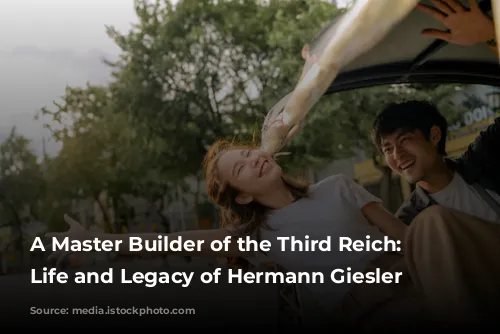Hermann Giesler, a prominent architect during the Nazi era, is a figure whose life intertwined with the rise and fall of the Third Reich. While his architectural accomplishments remain, his association with the Nazi regime casts a dark shadow over his legacy.
From Humble Beginnings to Nazi Architect
Giesler, born in 1898, was the son of an architect. His early career was marked by a diverse range of experiences, including service in World War I, work as a mason, carpenter, and joiner, and formal architectural studies. However, his professional life was profoundly shaped by his political affiliations. In 1931, he joined the Nazi Party, a move that would ultimately define his career. He also joined the SA, the paramilitary wing of the Nazi Party, solidifying his commitment to the Nazi cause.
In the early years of the Nazi regime, Giesler’s architectural career flourished. He was appointed Bezirksbaumeister (District Building Master) in Sonthofen in 1933. His design for the Ordensburg Sonthofen, a prestigious Nazi training center, marked the beginning of his involvement in prominent Nazi projects. He went on to design several other significant structures, including the Gauforum in Weimar, the Adolf-Hitler-Platz, and numerous other projects in Augsburg and the Chiemsee region. His architectural style, a blend of traditional German design and modernistic elements, reflected the Nazi ideology of grandeur and power.
Favoritism and Ambition
Giesler’s rise within the Nazi hierarchy was aided by his close relationship with Albert Speer, another prominent Nazi architect. Both men were favored by Adolf Hitler, who personally appointed Giesler as Generalbaurat (General Building Inspector) in 1938, putting him in charge of the rebuilding of Munich. He was further entrusted with the design of Hitler’s mausoleum.
However, Giesler’s ambitions extended beyond architecture. He was also involved in Nazi war planning, serving as the leader of the “Baugruppe Giesler” within the Organization Todt, a Nazi construction organization responsible for building fortifications and infrastructure during the war. His involvement with the Organization Todt brought him into direct contact with the horrors of the Nazi regime.
A Legacy of Controversy
Giesler’s life and career were inextricably linked to the Nazi regime. His architectural contributions, however impressive, are forever stained by his unwavering support for the Nazi ideology and his direct participation in the war effort. His involvement with the Organization Todt and the construction of factories using forced labor from concentration camps are among the most disturbing aspects of his legacy.
Giesler’s postwar fate reflected the complexities of his life. He was imprisoned and convicted of war crimes, but his sentence was eventually reduced, and he was released in 1952. He continued to work as an architect until his death in 1987, but his writings, which were filled with ardent support for the Nazi regime, cemented his legacy as a controversial figure whose life was marked by both artistic talent and deeply troubling moral choices.

Conclusion:
The life of Hermann Giesler is a reminder of the blurred lines between art and ideology. While his architectural contributions are undeniably impressive, his involvement with the Nazi regime and his unwavering commitment to the Nazi ideology leave a lasting stain on his legacy. His story serves as a stark example of the dark side of ambition and the devastating consequences of political extremism.










